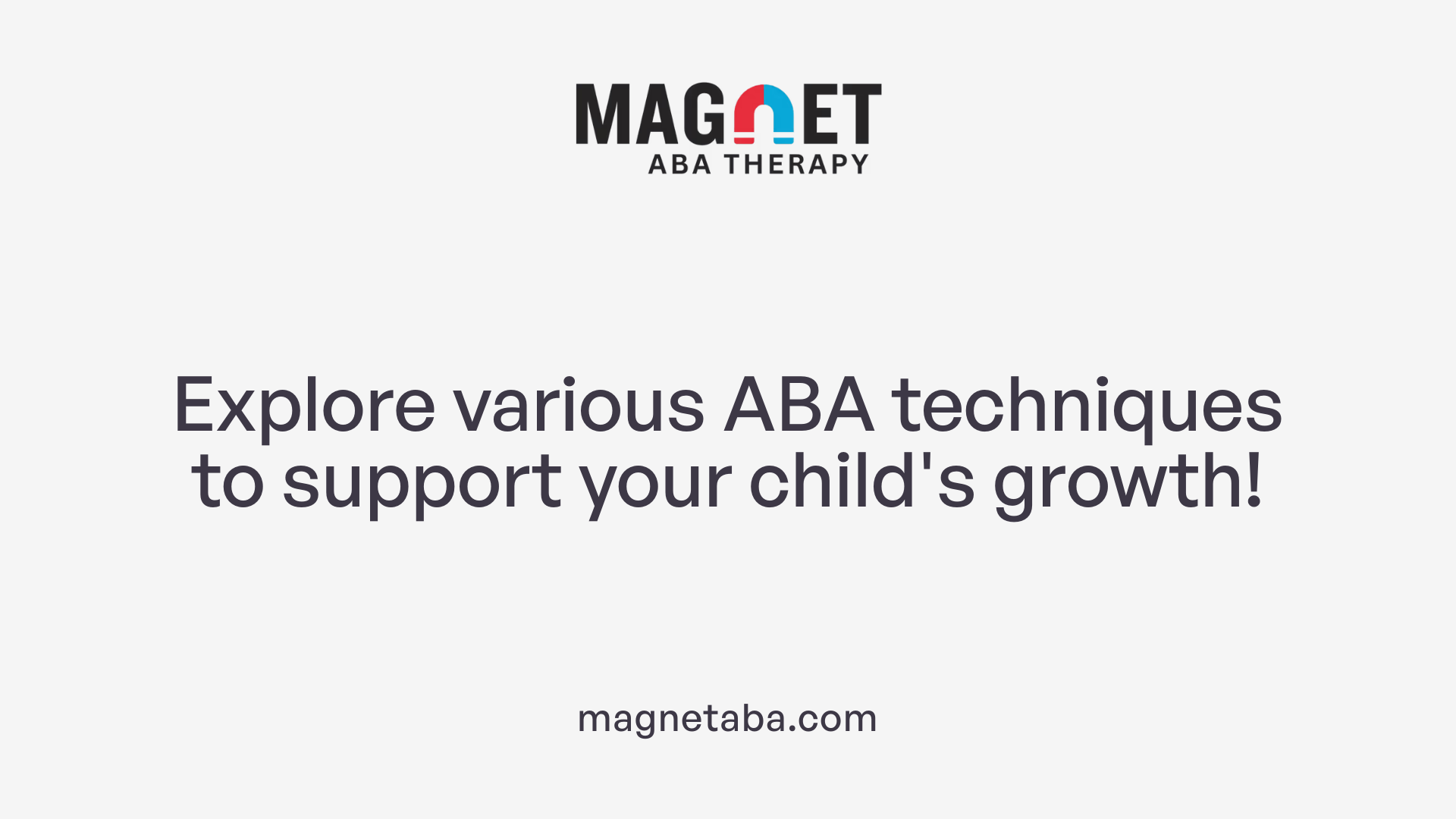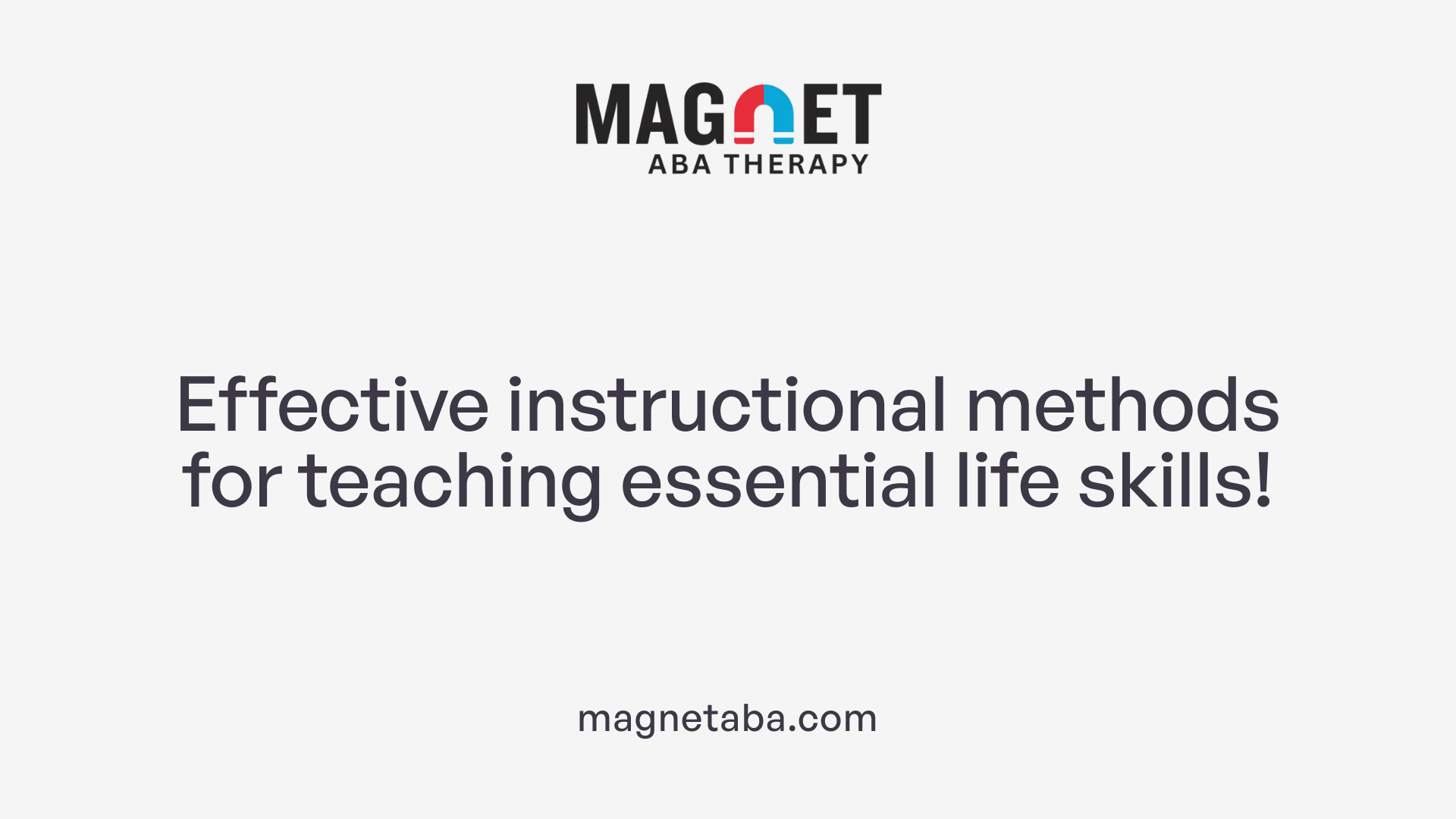Empowering Children with Autism to Take Responsibility
Teaching chores and responsibilities using Applied Behavior Analysis (ABA) strategies offers a systematic, evidence-based approach to nurturing independence, responsibility, and life skills in children, including those with autism. By applying specific techniques such as task analysis, reinforcement, and naturalistic teaching, caregivers and educators can facilitate meaningful skill development that translates into increased confidence and social connection. This article explores various ABA strategies, practical guidance, and resources for effectively teaching chores—ultimately contributing to a child's overall growth and autonomy.
Diverse ABA Techniques for Skill Development
 ABA, or Applied Behavior Analysis, utilizes various teaching methods to foster skill development in children, especially those with autism. Each technique is designed to target specific areas like social skills, communication, independence, and daily living activities.
ABA, or Applied Behavior Analysis, utilizes various teaching methods to foster skill development in children, especially those with autism. Each technique is designed to target specific areas like social skills, communication, independence, and daily living activities.
What are the different types of ABA therapy techniques and their benefits?
The most common ABA methods include Discrete Trial Training (DTT), Natural Environment Training (NET), Pivotal Response Treatment (PRT), Verbal Behavior Therapy (VBT), and the Early Start Denver Model (ESDM).
Discrete Trial Training (DTT)
DTT is a highly structured approach that breaks skills into small, manageable steps. It involves clear instructions, repetitive practice, and immediate rewards or reinforcement. This technique is especially effective in teaching specific skills like self-care routines or communication commands.
Natural Environment Training (NET)
NET emphasizes learning within everyday situations, promoting skills like social interaction, problem-solving, and motivation. It encourages children to learn through play and incidental teaching, making skills more relevant and easily generalized.
Pivotal Response Treatment (PRT)
PRT targets pivotal areas such as motivation, response to multiple cues, and self-management. By focusing on these critical points, children often show broad improvements across various skills, including social engagement and language.
Verbal Behavior Therapy (VBT)
VBT concentrates on developing language and communication. It reinforces verbal attempts and encourages spontaneous speech, significantly benefiting children struggling with expressive language.
Early Start Denver Model (ESDM)
ESDM combines ABA principles with developmental science, often used with very young children. It involves play-based activities and parent involvement, fostering social-emotional skills, language, and cognitive development.
Benefits of Each Method
| Technique | Main Focus | Highlights | Benefits |
|---|---|---|---|
| DTT | Skill acquisition | Structured, repetitive | Clear progress tracking, effective for teaching specific skills |
| NET | Natural social skills | Learning in real-life settings | Enhances generalization, motivation |
| PRT | Pivotal areas | Child-led, motivating | Broad developmental improvements |
| VBT | Speech and language | Reinforcement of verbal behaviors | Improves communication skills |
| ESDM | Developmental skills | Play-based, family involved | Holistic growth, early intervention |
Each of these techniques offers unique advantages and can be combined based on individual needs, making ABA a versatile and evidence-based approach. They are particularly effective in teaching everyday skills such as chores and life responsibilities, reinforcing independence and confidence in children.
Implementing ABA Strategies in Daily Routine

Step-by-step guidance for teaching chores
Teaching chores to children, especially those with autism, benefits greatly from applying ABA techniques. Start by using task analysis to break down chores into small, manageable steps. For example, brushing teeth can be divided into picking up the toothbrush, applying toothpaste, and brushing. Provide visual aids or checklists to guide each step, and model the task to demonstrate the correct way.
Once the child practices each step with support, gradually fade prompts and prompts as they become more independent. Increase the child's responsibility by encouraging them to initiate tasks and complete chores without prompts. Reinforce their efforts consistently with praise or tokens, which can be exchanged for preferred items or activities. Make tasks engaging by pairing chores with play and offering choices—this boosts motivation.
Role of reinforcement and visual supports
Positive reinforcement is essential in ABA. Use praise, tokens, or access to preferred items to motivate children during chores. Reinforcers should be meaningful to the child and delivered immediately after task completion.
Visual supports such as picture schedules, timers, and step-by-step checklists help children understand expectations and stay focused. Visual timers can also help children develop time management skills, creating a clear expectation of how long chores should take. Incorporating visual aids also supports generalizing skills across different settings.
Making chores a routine that is predictable and structured allows children to develop independence and self-confidence. Pairing chores with play, providing choices, and using reinforcement strategies help sustain engagement and foster long-term success.
Practical Resources:
- Online training modules and tutorials
- Visual schedule templates
- Video demonstrations of chores
- Behavior management and reinforcement strategies guides
Implementing these steps with consistency and patience can foster responsibility, independence, and a sense of accomplishment in children, supporting their overall development.
Instructional Techniques for Teaching Daily Living Skills

What are common instructional techniques used in ABA to teach daily living skills?
Applied Behavior Analysis (ABA) employs various effective methods to help children, including those with autism, develop essential daily living skills. One fundamental approach is task analysis, which involves breaking down complex chores or activities into small, manageable steps. For example, brushing teeth might be divided into picking up the toothbrush, applying toothpaste, brushing, and rinsing.
Prompting is another vital strategy, providing guidance during the initial learning stages. This includes verbal prompts, physical assistance, or visual cues. To ensure children become independent, prompt fading gradually reduces these supports as the child gains mastery.
Chaining techniques—forward, backward, and total chaining—are used to teach sequences of tasks. Forward chaining starts with teaching the first step, then gradually adds subsequent steps. Backward chaining begins with the last step, progressing backward to the beginning. Total chaining involves teaching all steps together until the entire sequence becomes automatic.
Reinforcement plays a crucial role in motivating children. Token systems, praise, and access to preferred items motivate children to engage and succeed in chores. Integrating learning into everyday routines through Natural Environment Training (NET) helps children generalize skills beyond structured lessons. Visual supports such as picture schedules assist children in understanding what is expected, providing clarity and structure.
Data collection methods, including ABC (Antecedent-Behavior-Consequence) data, help tailor interventions by analyzing behavior patterns. These strategies collectively promote independence across self-care, household management, and community activities, fostering confidence and essential life skills that contribute to long-term success.
Fostering Responsibility and Independence Through Chores

Can ABA help children develop responsibility and independence through teaching chores?
Absolutely. Applied Behavior Analysis (ABA) is a proven, evidence-based approach that effectively supports children, including those with autism, in developing essential life skills such as responsibility and independence through chore training.
ABA techniques focus on structured, systematic methods to teach chores, often involving breaking down complex tasks into manageable steps through a process called task analysis. This allows children to learn each part of a chore sequentially, reducing frustration and building confidence.
Reinforcement plays a central role in motivating children to complete chores. Using positive reinforcement, such as praise, tokens, or access to preferred items, helps reinforce the behavior and encourages consistent participation.
Visual supports like checklists, visual schedules, and timers further enhance understanding and help children follow routines independently. These tools act as prompts and guides, gradually fading over time to promote autonomy.
In addition to direct teaching, ABA incorporates natural environment teaching and involves families in the process, ensuring that skills learned are generalized across different settings such as home, school, and community.
Fading prompts and supports steadily over time allows children to take ownership of chores and perform them independently. This process nurtures personal responsibility and boosts self-confidence.
In summary, ABA's structured strategies and focus on reinforcement are highly effective for teaching chores. They foster responsibility, promote independence, and ultimately support children in gaining vital skills for daily life.
Strategies for teaching chores to children with autism
| Strategy | Description | Benefits |
|---|---|---|
| Breaking tasks into steps | Using task analysis to simplify chores into small, manageable parts | Easier learning curve, increased confidence |
| Visual supports | Using schedules, checklists, and visual aids | Better comprehension, independence in task completion |
| Pairing chores with play | Making chores enjoyable by combining with play or preferred activities | Increased motivation, long-term engagement |
| Timers and visual prompts | Using visual timers and cues to structure routines | Improved time management, routine adherence |
| Reinforcement and praise | Providing positive feedback and rewards | Sustains motivation, builds self-esteem |
These approaches, combined with patience and consistency, enable children to master household responsibilities and develop essential self-management skills.
Making Chores Engaging and Achievable
 Applying ABA principles to make chores engaging for children involves several structured strategies that promote learning and responsibility.
Applying ABA principles to make chores engaging for children involves several structured strategies that promote learning and responsibility.
One effective approach is breaking down complex chores into smaller, manageable steps through task analysis. This reduces feelings of being overwhelmed and helps children build confidence as they master each part of the task.
Visual supports are also vital. Using picture checklists, visual schedules, and timers helps children understand what needs to be done, stay organized, and remember each step. These visual aids serve as prompts and reinforce understanding, making the chores more accessible.
Incorporating positive reinforcement is central. Praising children, providing tokens, or offering access to preferred items or activities when they complete chores boosts motivation and encourages continued effort.
Prompting techniques, such as verbal cues or physical guidance, support children as they learn new tasks. Over time, prompts are gradually faded to foster independence.
Turning chores into fun, playful activities or pairing them with rewards can make responsibilities more appealing. For example, turning wiping the table into a game or offering a favorite sticker after tidying up encourages participation.
By combining these ABA strategies—breaking tasks down, using visual aids, applying reinforcement, and adding elements of play—parents and educators can effectively teach children responsibility and daily life skills, setting the foundation for independence.
| Strategy | Description | Beneficial Outcome |
|---|---|---|
| Task analysis | Breaking chores into manageable steps | Reduced overwhelm, increased independence |
| Visual supports | Checklists, schedules, timers | Better understanding, organization |
| Positive reinforcement | Praise, tokens, preferred items | Increased motivation, confidence |
| Prompting and fading | Verbal cues, physical guidance, gradually removing prompts | Developing independence |
| Pairing chores with play | Making chores fun or rewarding | Enhanced engagement, enjoyment |
These strategies foster not only the mastery of chores but also promote confidence and social connection, which are crucial for overall development.
Fostering Growth and Responsibility
Implementing ABA strategies for teaching chores and responsibilities provides children with autism and other developmental needs an effective pathway to independence. Through systematic use of task analysis, reinforcement, visual supports, and naturalistic teaching, caregivers can make learning engaging, manageable, and meaningful. Over time, these approaches promote skill generalization, responsibility, and self-management, laying the foundation for greater autonomy and confidence in daily life. Long-term success is supported by ongoing goal adjustment, collaborative efforts, and fostering a growth mindset, ultimately enriching the child's quality of life and participation in their community.
References
- Should I Teach My Child to Do Chores? Why It Matters and How ...
- Making Chores Fun: Using ABA Principles to Teach Responsibility
- At-Home Chores for Kids with Autism - Innovative Behavior Options
- How ABA Therapy Helps Build Daily Living Skills | Dream Big
- Self-Management Skills: Teaching Independence and Responsibility
- How ABA Therapy Helps with Daily Living Skills
- 11 Evidence-Based Ways To Teach Daily Living Skills











